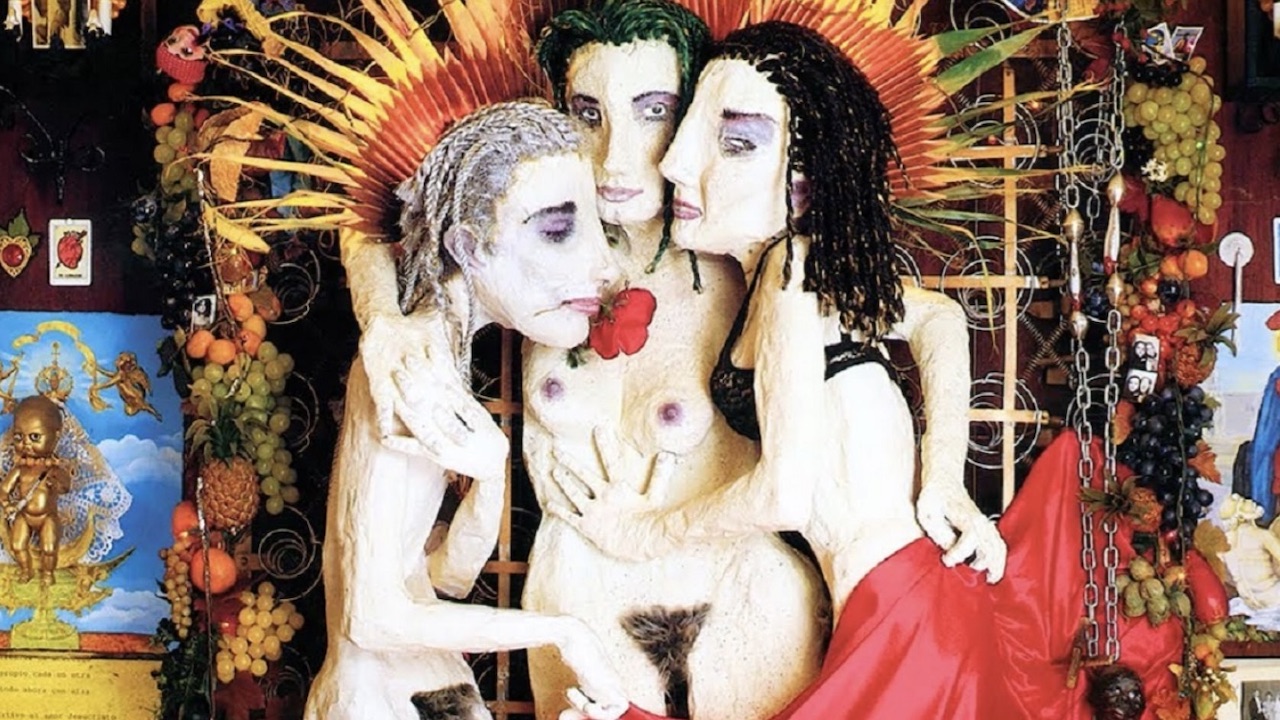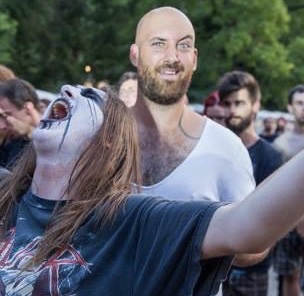Whilst it is unquestionably true that Nirvana were the band that turned alternative music into the cultural behemoth that it became in the 1990s, their game-changing break-through didn't happen in isolation.
In the years before the phenomenal success of Nevermind helped cultivate a culture in which grunge would become the definitive musical movement of the era, Pixies, Sonic Youth, Faith No More, Dinosaur Jr. and more made important, incremental advances in expanding the mainstream's awareness of outsider art. But one band more than any other were responsible for drawing the underground and the pop charts closer together.
Jane's Addiction may have originated in the same city as the hair metal bands who dominated the rock scene in the 1980’s, and even shared some of their hedonistic instincts, but the LA quartet's intentions as a collective were a world away from the concerns shared by the leather-and-lace clad glamour boys packing out Sunset Strip clubs. As a new decade dawned, Janes were poised to become the band who would define the next generation... but their efforts to execute a definitive musical statement for this brave new world would come at a heavy cost.
If the names Perry Farrell, Dave Navarro, Eric Avery and Stephen Perkins were not yet familiar to the vast majority of music listeners at the outset of the '90s, the music made by the quartet was starting to impact beyond LA's city limits.
Nothing’s Shocking, their debut release on Warners, had sent shockwaves through the underground when it emerged in the summer of 1988, it’s mixture of psychedelic rock, funk and metallic riffs allied to frontman Farrell’s mystic, spiritual musings were utterly unlike anything heard elsewhere in mainstream metal or alternative rock. It was a fantastic record, boosted by rave reviews in the UK music press and a genuine crossover hit in the form of single Jane Says, first heard on the group's self-titled 1987 live album, so one might imagine that the challenge of bettering it could have proved somewhat daunting? And indeed it might have done, had Janes Addiction not deliberately, and boldly, saved the best songs they had yet written for inclusion on their second studio album.
“I remember thinking, ‘You know, everybody always talks about the sophomore jinx,” Perry Farrell told Billboard. “I thought, ‘I’m gonna fuck that sophomore jinx right out of my life with these songs.’ Because, this first batch of songs [on Nothing’s Shocking], they’re gonna be punchy — it’s like punching through a wall. But then, when you get on the other side of that wall, this record comes.”
History would show that this audacious gamble paid off magnificently for Farrell's band. Which was fortunate, because the stockpiling of the cream of the quartet's creative endeavours was pretty much the sole element that ran smoothly during the creation of Ritual de lo Habitual...
The vibe of the sessions for Jane's Addiction's second album was fraught from the very beginning, when, while the band were setting up in LA’s Track Record studios with producer Dave Jerden in late 1989, Perry Farrell raised the tricky subject of finances with the rest of the band. The singer voiced his belief that he was due 50% of future royalties due to him being the band's sole lyric writer, and also insisted that, as a proven contributor to the music, he was also entitled to one quarter of the remaining 50%, adding up to a 62.5% share of the money generated by the recordings the group were about to make. Unsurprisingly Navarro, Avery and Perkins were not best pleased.
“When it comes to money and stuff like that, he’s pretty aggressively self-interested,” Eric Avery told Billboard. “I remember famously Dave played one of our shows after that and put on a t-shirt that said “12%” or something, because that was the amount that was going to be left for him in Perry’s system. So, it left some resentment, for sure.”
To make his own displeasure known, Avery himself would refuse to play on the recording of Of Course due to what he considered dictator-like behaviour from the group's frontman.
“Perry was the guy who was telling everyone what to play,” revealed album engineer Ronnie S. Champagne. “I remember sitting in the control room and Perry’s singing guitar solos to Navarro. Like, ‘No, no, no — that’s not it! It’s like this,’ and he’d sing it out! That was heavy, I had never seen that before.”
The situation escalated to the point where Dave Jerden arrived at the studio one morning to be told by Farrell that the band had split and there would be no record. It took an intervention from Warner Bros. to sort the dispute, and cajole the band members to finish the record. Farrell would his desired cut, but the collateral damage to the unit would prove terminal.
As if this conflict was not poisonous enough, the sessions were hampered further by the fact that the drug habits of certain members of the band’s drug usage were spiralling out of control. Dave Navarro would later admit that he has no recollection of recording his parts on the album, such was his addiction to heroin addiction.
"We'd try to pull rehearsals together and Dave would call and say, 'Oh, I can't make it.” Stephen Perkins told Spin magazine in 1991. “Perry would show up two hours late. Because of drugs. They were just more into getting high than working.”
Given the many obstacles faced during the studio sessions, Ritual de lo Habitual has no right to sound as perfect as it does.
Listening to the record today, Ritual... still feels like it has been beamed down from another planet. On paper it’s a disjointed and confusing album, with two distinctly different halves smooshed crudely together; how the choppy, dance rock of Been Caught Stealing and the swooping lament of Then She Did, inspired by the death of Perry Farrell’s mother, be expected to work within the confines of the same album? But for all the tensions dogging its creation, with Ritual... Janes Addiction had captured true magic.
The journey that the album takes listeners on is truly stunning, hooking one in with funky, instantaneous and anthemic rock songs in its first half, with the careering Stop and the honky-tonk piano and wah-wah wiggle of Obvious gifts for MTV, before the grandiose, experimental, psychedelic and progressive second act comes in and takes everything to new heights.
Much of the latter half of the record was inspired by Farrell’s late girlfriend Xiola Blue, who died from a heroin overdose in 1987, at the age of 18.
"When you have something like that happen…" the vocalist once told Classic Rock. "the better thing to do is to try to make some flowers grow out of it."
The songs on Ritual's second half are lengthier and different in tone, with the ten-minute-plus Three Days emerging as the album's centrepiece and highlight. Inspired by a three-day sex and drug fuelled ménage à trois that Farrell shared with Blue and his partner Casey Niccoli, the song sounds more like Led Zeppelin at their most expansive or early Pink Floyd at their wildest and most psychedelic, as it does anything to do with alternative rock.
With a swerving, expressive guitar solo from Navarro, some ever intensifying, tribal rhythmical pounding from Avery and Perkins, and Farrell repeatedly bawling “All of us with wings” as the song begins to climax, it’s as breathtaking, powerful and inspiring as music gets.
From there Ritual de lo Habitual begins to slowly, beautifully fade, with the closing trio of Then She Did..., Of Course and Classic Girl being quieter, more reserved and more delicate than the rest of the album. It all adds up to a magnificent, poignant, alluring listen.
The band's troubles weren’t quite over yet though. This time the issue was the album artwork, created by Farrell, inspired by the events detailed in Three Days, and featuring images of full frontal nudity, being rejected by many of America's more conservative retail chains. A second cover was duly created by the singer, featuring text quoting the First Amendment regarding freedom of speech on the front and, on the back, the words “Hitler's syphilis-ridden dreams almost came true. How could it happen? By taking control of the media. An entire country was led by a lunatic… We must protect our First Amendment, before sick dreams become law. Nobody made fun of Hitler??!.” Farrell had made his point.
Released on August 21, 1990, Ritual... was met by love from fans and critics alike. In one of many enthusiastic reviews, Spin declared "It all makes you realise how few bands actually bother to try and be any good, to play stuff that's inspirational." The record went on to sell over 2 million copies in the US alone, entering the Billboard top 200 at number 19, and also cracking the UK top 40.
As Jane's toured the album, headlining the first Lollapalooza festival, conceived by Farrell after visits to European festivals, they significantly boosted the profile of alternative rock in the US. But the tensions that had surfaced during the recording sessions wouldn’t go away. Farrell continued to indulge in his drug habit, whilst the newly clean Navarro joined the already sober Avery in distancing himself from the rest of the touring party and its temptations. But the fractures could not easily be papered over, and after shows in Australia and Hawaii in late 1991, Janes Addiction split.
They would return, minus Eric Avery, and make some fine music together in their second act, but over three decades since it began to inspire an entire new generation of young people to think about music in new ways, and brought craft, intelligence, sensitivity and genuine artistic intent into hard rock, Ritual de lo Habitual remains Janes Addiction’s definitive musical statement. Without it, your life is not complete.

